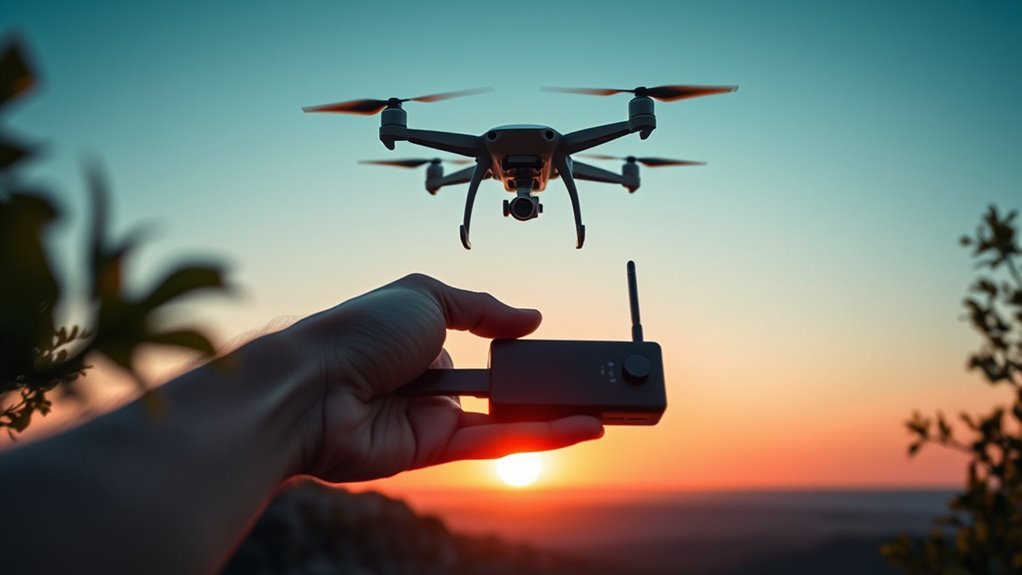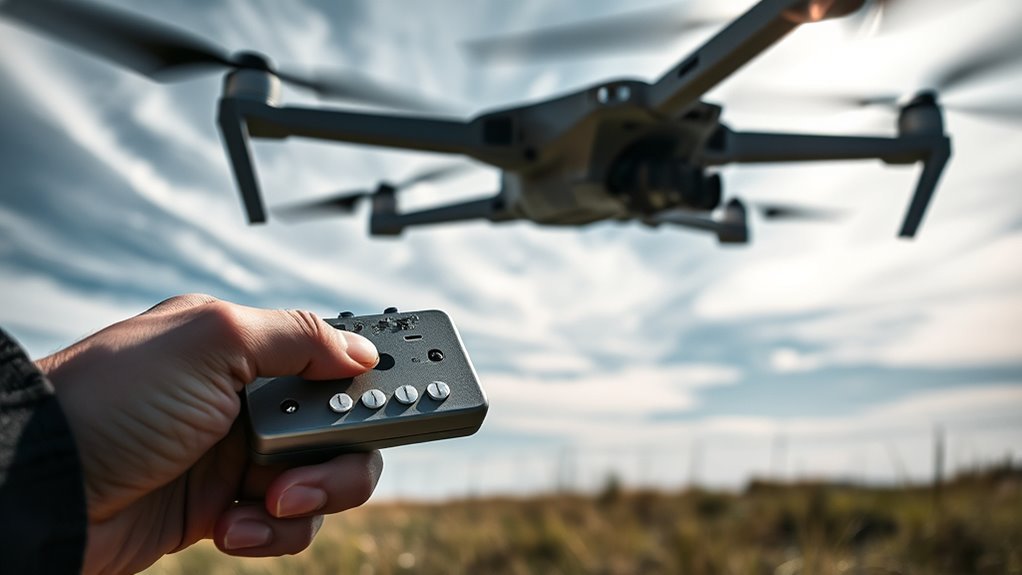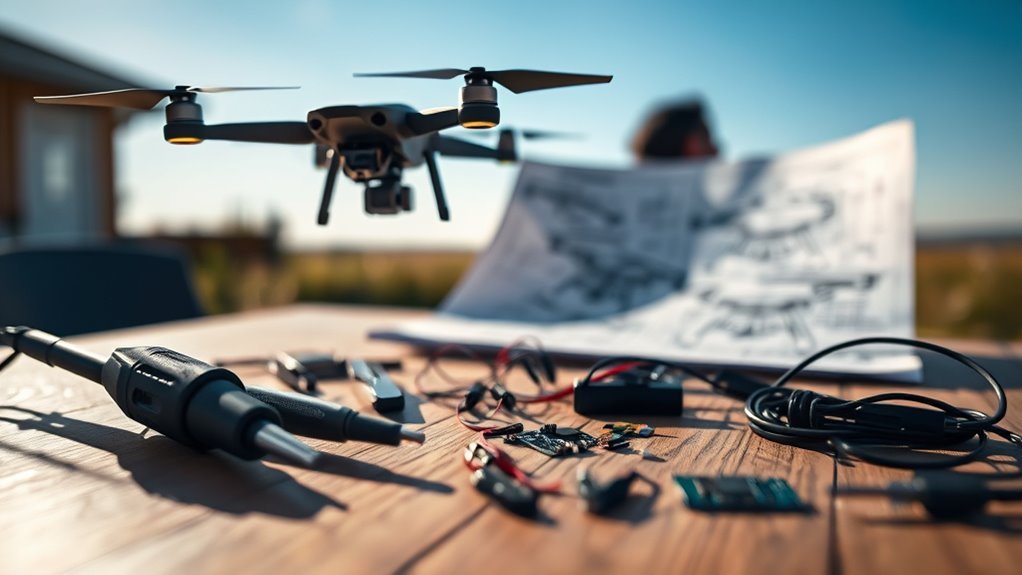To jam drones effectively, start by understanding their technology and communication methods. Get familiar with signal jamming techniques, like frequency matching and power adjustments. Make sure you’re compliant with FCC rules and local laws to avoid legal issues. Gather the right equipment, including multi-frequency jammers and antennas, and follow a systematic setup process. Troubleshoot common problems, maintaining safety with regular training and equipment checks. Continue to explore advanced strategies for peak jamming and effectiveness.
Understanding Drone Technology

When you explore drone technology, you’ll discover a complex interplay of hardware and software that enables these flying devices to operate efficiently. Key drone components include the flight controller, motors, propellers, and sensors, all of which work together to guarantee stable flight. The flight controller processes data from various sensors and interprets it to maintain balance and navigation. Additionally, communication relies heavily on signal frequency, allowing the drone to receive commands and transmit data back to the operator. Understanding these elements not only enhances your knowledge of drone functionality but also empowers you to utilize this technology to its fullest potential. Mastering these fundamentals will grant you the freedom to innovate and adapt drones for various applications. Furthermore, an awareness of advanced camera capabilities can significantly enhance the quality of the content you capture with your drone. For instance, understanding image stabilization technology can help you achieve smoother footage in dynamic shooting conditions.
Overview of Signal Jamming

Signal jamming involves disrupting communication between a drone and its controller, effectively rendering the drone inoperable. You’ll need to understand various jamming techniques to implement this strategy effectively, as well as the legal implications surrounding the use of such methods. Maneuvering these considerations is essential for responsible operation and compliance with regulations.
Jamming Techniques Explained
Although various jamming techniques exist, understanding the fundamentals of signal jamming is essential for effective application. At its core, signal jamming involves creating interference that disrupts communication between a drone and its operator. You can achieve this through methods like noise jamming, where you generate random signals, or deceptive jamming, which sends false signals to mislead the drone. The jamming effectiveness largely depends on factors such as frequency range and power output. By knowing the specific frequencies used by the drone, you can tailor your approach to maximize signal interference. Mastering these techniques not only enhances your operational capability but also empowers you to reclaim control over your airspace, promoting a sense of freedom in the face of unwanted drone activity.
Legal Considerations Overview
While jamming techniques can be effective for disrupting drone operations, it’s crucial to understand the legal implications surrounding their use. Ignoring these can lead to serious legal ramifications, including hefty fines or criminal charges. To navigate this complex landscape, consider the following:
- Federal Regulations: Familiarize yourself with the Federal Communications Commission (FCC) rules on signal jamming.
- State Laws: Research your state’s specific laws regarding jamming devices and their use.
- Regulatory Compliance: Verify any action taken aligns with local and federal compliance standards.
- Potential Consequences: Be aware of the risks, including civil litigation and enforcement actions.
Legal Considerations for Jam Drones

When using jam drones, you need to be aware of the legal landscape, which includes federal regulations governing signal jamming. Additionally, state-specific laws can vary greatly, impacting your usage rights. Understanding potential liability and penalties is essential to guarantee compliance and avoid serious legal repercussions.
Federal Regulations Overview
As you navigate the complex landscape of jam drones, it’s important to understand the federal regulations that govern their use. These rules are enforced by federal authorities, and keeping abreast of drone regulation updates is vital to guarantee compliance. Here are key aspects to take into account:
- Federal Authority Roles: The FAA oversees airspace management and drone operation standards.
- Prohibited Activities: Jam drones are often classified as illegal under federal law, posing significant legal risks.
- Licensing Requirements: Operators may need specific licenses depending on the drone’s use.
- Penalties for Non-Compliance: Violating regulations can lead to hefty fines and potential criminal charges.
Understanding these points will help you navigate the legalities of using jam drones effectively.
State-Specific Laws
Understanding state-specific laws is vital for anyone operating jam drones, since regulations can vary considerably from one jurisdiction to another. You need to familiarize yourself with your state’s laws, as some may impose stricter regional regulations than others. Local enforcement agencies often interpret these laws differently, which means compliance requirements can change based on where you operate. For instance, certain states may require permits or specific operational guidelines that dictate how and where you can deploy jam drones. It’s important to stay informed about updates in legislation to guarantee you remain within legal boundaries. Ignoring these laws can lead to complications, undermining the very freedom you’re seeking to maintain through drone operation.
Liability and Penalties
While operating jam drones can seem straightforward, the potential for liability and penalties is a significant concern that operators must address. Ignoring these liability concerns can lead to severe penalty implications. Here are key points to take into account:
- Legal Compliance: Confirm your activities abide by federal and state regulations.
- Insurance Coverage: Obtain liability insurance to protect against potential damages.
- Operational Guidelines: Follow strict protocols to minimize risks during operations.
- Incident Reporting: Be prepared to report any incidents involving your jam drones to the relevant authorities.
Understanding these factors will help you navigate the complexities of operating jam drones responsibly, confirming you maintain your freedom while minimizing risks associated with liability and penalties.
Essential Equipment for Jamming
To effectively jam drones, you’ll need specific equipment designed to disrupt their communication and navigation systems. First, a reliable jamming device is vital; it should operate at multiple jamming frequencies to target various drone models effectively. Look for devices that allow you to adjust signal strength, as this can enhance your control over the disruption range. Additionally, antennas designed for both omnidirectional and directional use will provide flexibility in targeting specific drones or areas. A power supply capable of supporting extended operations is essential, ensuring your equipment runs without interruption. Finally, having real-time monitoring tools will help you assess the effectiveness of your jamming efforts, allowing for adjustments as needed to maintain peak interference.
Setting Up Your Jam Drone
To successfully set up your jam drone, you’ll need to gather a specific set of equipment. This checklist guarantees you have all the necessary components for installation. Understanding the installation process will help you configure your system efficiently and effectively.
Required Equipment Checklist
Before you can successfully set up your jam drone, you’ll need to gather specific equipment that guarantees peak performance and functionality. Here’s a checklist to make sure you’re prepared to tackle signal interference effectively:
- Jamming Devices: Choose reliable jamming devices compatible with your drone’s frequency.
- Power Supply: Confirm you have a robust power source to keep your devices operational for extended periods.
- Signal Analyzer: This tool helps you assess the surrounding frequency environment, allowing you to optimize your setup.
- Protective Gear: Safety first! Equip yourself with necessary protective gear to handle equipment safely.
With these essentials in hand, you’re well on your way to setting up your jam drone and achieving your desired results.
Installation Process Overview
Although setting up your jam drone may seem intimidating at first, following a systematic process can streamline the installation and guarantee peak performance. Here’s a brief overview of common installation challenges and best practices to keep in mind:
| Step | Challenge | Best Practice |
|---|---|---|
| Initial Setup | Incompatible components | Verify compatibility first |
| Software Installation | Conflicting software versions | Always update to latest version |
| Calibration | Misalignment issues | Follow calibration guide closely |
Techniques for Effective Signal Jamming
When you’re looking to implement effective signal jamming techniques, understanding the operating principles of both the target drone and the jamming device is crucial. To enhance your jamming effectiveness and create strong signal interference, consider these key strategies:
- Frequency Matching: Identify the drone’s operating frequency and match your jamming signal accordingly.
- Power Output: Adjust the jamming device’s power output to guarantee it exceeds the drone’s signal strength.
- Directional Antennas: Utilize directional antennas to focus the jamming signal precisely on the target.
- Timing and Duration: Time your jamming efforts for maximum impact, ensuring sustained interference to disrupt communication.
Troubleshooting Common Issues
While signal jamming can effectively disrupt drone operations, you may encounter common issues that hinder performance. First, check for signal interference from nearby devices, as this can dilute your jamming effectiveness. Verify your jamming frequency aligns with the drone’s operating frequency; mismatches can lead to poor results. If your jamming device isn’t working, inspect the power supply and connections to rule out hardware malfunctions. Employ troubleshooting techniques like adjusting the jamming distance and direction for peak disruption. Additionally, observe environmental factors, such as obstructions or weather conditions, that may affect signal propagation. By identifying these issues and applying targeted solutions, you can enhance your signal jamming efforts and reclaim your freedom from unauthorized drone activity.
Safety Precautions When Operating
Before you operate jamming devices, it’s important to understand and implement safety precautions to mitigate risks. Adhering to these guidelines can help guarantee a safe experience for you and others:
- Conduct Regular Drone Maintenance: Confirm all equipment is in peak condition to prevent malfunctions.
- Complete Operator Training: Familiarize yourself with jamming technology and local regulations to operate effectively.
- Choose a Safe Operating Environment: Avoid crowded areas to minimize risks to uninvolved parties.
- Monitor Surroundings: Always be aware of nearby drones and their operators to prevent unintended interference.
Advanced Jamming Strategies
Having established the importance of safety precautions, it’s time to explore advanced jamming strategies that enhance operational effectiveness. To effectively implement counter drone tactics, you should consider diverse signal interference methods tailored to the specific drone you’re targeting. Techniques like frequency hopping can disrupt communication channels, while directional jammers focus signal power on a targeted area, maximizing disruption. Employing a combination of active and passive jamming can also improve success rates; active methods directly disrupt signals, while passive methods involve creating deceptive signals to confuse the drone’s navigation systems. Remember, understanding the drone’s communication protocols is vital for effective jamming. By mastering these strategies, you can assert your freedom in the skies while neutralizing unwanted drone threats efficiently.
Future Trends in Jam Drones
As the drone industry continues to evolve, staying ahead of emerging trends in jamming technology is crucial for maintaining effective countermeasures. Here are some future trends you should watch for:
- AI Integration: Leveraging artificial intelligence to enhance targeting accuracy and response times.
- Miniaturization: Developing smaller, more portable devices for personal and tactical use.
- Enhanced Signal Processing: Utilizing advanced algorithms to improve jamming effectiveness across various frequencies.
- Industry Applications: Expanding jamming capabilities into sectors like agriculture, security, and logistics for greater operational freedom.
Frequently Asked Questions
What Types of Drones Can Be Jammed Effectively?
You can effectively jam various types of drones, including commercial drones and military drones. Each has specific frequency bands and communication protocols, allowing targeted jamming techniques to disrupt their operations and guarantee your privacy and freedom.
How Do I Choose the Right Frequency for Jamming?
For effective frequency selection, focus on finding the specific bandwidth your target drone uses. Signal interference works best when you match or slightly overlap those frequencies, disrupting communication and ensuring you’re achieving maximum impact without collateral effects.
Is Jamming Effective Against All Drone Models?
Jamming isn’t effective against all drone models due to varying drone technology and jamming limitations. Some drones have advanced features that can bypass jamming, so understanding specific models is essential for effective countermeasures.
Can Jamming Be Used for Recreational Purposes?
“Curiosity killed the cat,” but drone enthusiasts should tread carefully. Jamming for recreational use can lead to serious legal implications. It’s essential to understand the laws before attempting any jamming, as freedom has its limits.
What Are the Consequences of Illegal Jamming Activities?
If you engage in illegal jamming activities, you could face severe legal repercussions, including fines or imprisonment. Additionally, safety concerns arise, as jamming can disrupt critical communications, endangering lives and public safety.

